It’s no understatement to say that the SEO industry changes at an unbelievable pace.
But as SEOs, we have no option but to keep up.
That’s why, every year, I pay close attention to what Google is doing. I observe the latest SERP developments and look for signals of what the search engine might be introducing in the future.
At seoClarity, we also collect an incredible amount of data that sheds light on many of Google’s developments.
Each year, I compile my observations about the state of the enterprise SEO industry, and below I’ve listed what you should be paying attention to in 2020.
(Note, you can download the previous edition here.)
Learn about what strategies will be worth your effort in the coming year, and what strategies only appear valuable to your strategy.
But first, let me put the situation in perspective.
The Pace of Google’s Evolution
Google is 21 years old, and so much has changed since the search engine’s inception.
In the first ten years, much of its development revolved around the algorithm. It was driven by links and keyword usage and displayed organic results as the ten blue links.
During that time, Google updated rankings infrequently, and there hadn’t been much volatility of the SERPs.
The next ten years, from 2007-2017, brought more changes, of course. However, the pace of Google’s development was still steady.
We saw faster indexing, and faster and richer web results. Google had begun tackling quality issues with various algorithm updates. It started analyzing the quality and quantity of links, too.
But nothing compares to the speed of development over the last two years!
More new things have happened to Google in the last 24 months than in the last two decades combined.
We’ve seen developments with Rankbrain, BERT, AI, and mobile search. Voice search, the Hummingbird update, and a new understanding of the semantic context behind the search query have changed the way Google processes information. Other updates include Google Hotels, Google Flights, and local listings – and this is only scratching the surface.
Google has not reached its full maturation point where it makes decisions autonomously, but we are very, very close to that point. Regardless, it’s safe to say that things have changed – the search engine has an amazing understanding of the world today, all within a time period that defied expectations. It identifies, analyzes, understands, and delivers the exact information on any type of query or intent behind it.
In fact, it’s hard to not stand in awe of its abilities, particularly if you consider how search looked only five or so years ago.
So, how do these changes affect the future of the industry?
Let’s have a look.
#1. The SERP is Not the SERP Anymore
The SERP has greatly evolved since its origin.
In the past, any search query would return nothing more than some ads and the ten blue links.
Over time, the results expanded with PLAs, local results, images, and top stories, but that was about it for a long while. However, we saw a growing number of Google embedded features, designed to keep looping the user back to a Google property.
Today, there are over 810 unique features on the SERP page.
Granted, not all of those features appear on the page at once. In fact, many are just elements that are testing but haven’t rolled out yet. Nonetheless, the number of possible SERP displays is massive.
What’s more, these results, and whether they appear for a query, differ depending on many factors: location, browsing history, and more.
Overall, out of those 810 features, 161 are found on more than 0.2% of keywords, according to our research.
These are the most prevailing features that Google has rolled out and they appear in SERPs across the globe.
How does this affect your strategy?
Well, the variety and speed at which Google is launching new features result in ranking shifts and fluctuations, for one. A few years ago, the search result in the first rank position would be shown at the top of the screen. Today, the Google features push it down beneath the fold, which is quite a different search experience.
What’s more, zero-click searches are increasing, and affect your visibility too. In fact, 50.33% of all searches are zero-click. This finding caused panic about the state of SEO, but the future of the industry is lively.
We conducted an analysis across all of our clients that have allowed us to benchmark their data. Across more than 500 sites and 19 billion clicks in the last 12 months, organic search accounted for the most traffic (29.5% on average).
#2. A Rank is No Longer a Rank
As stated, the concept of the ten blue links has changed tremendously.
Today, organic listings offer a more visual experience with various metadata and other elements. What’s more, different positions in the SERP feature a different experience.
Consider this result for example.
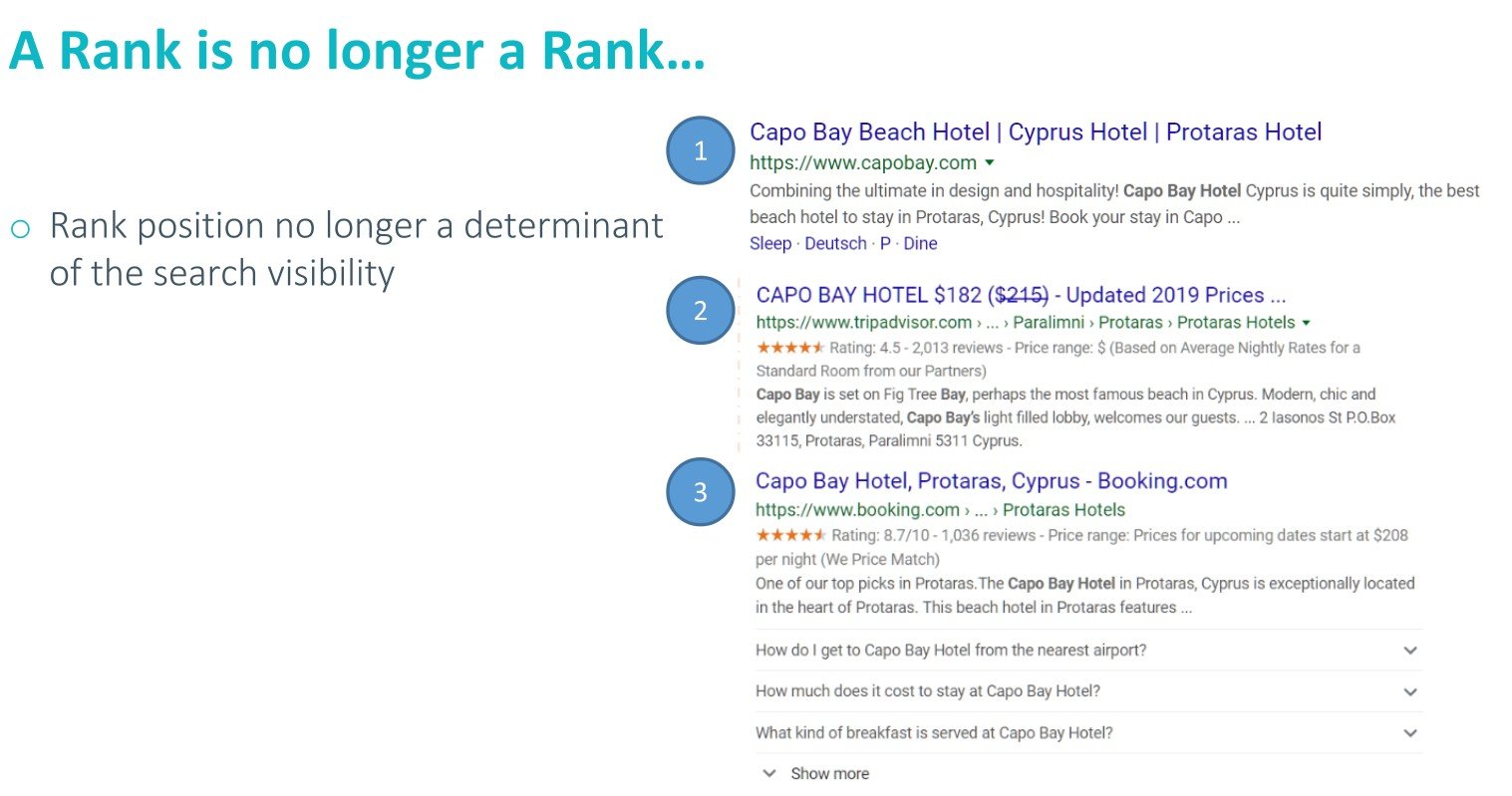
(Search listings showing an FAQ markup and star rating.)
Note how it’s the third result that features the most elements, not the first.
The first result features site links only. The second adds the star ratings. But it’s rank position three that boasts an impressive FAQ section, making it stand out on the page.
As a result, rank is no longer a determinant of search visibility. Any results further down the page equipped with a better visual experience will attract more clicks.
Similarly, a page ranking in position five or so may easily appear in the answer box, ultimately becoming the most noticeable result in SERPs.
In fact, we looked at the CTR data we have for our benchmark clients over the course of a year, and what we found was surprising. On both desktop and mobile, there was an 8% drop in CTR for rank position one. Interestingly, position two had a 4% increase.
Note, the experience on mobile is so significantly different. Whatever we see on desktop, there is 5x as much on mobile.
How does this affect your strategy?
Rankings no longer define the actual search visibility. In spite of having top rankings, a page may no longer receive the majority of clicks due to other results being more prominent.
This development affects your strategy in two ways:
- You must develop other ways to report on the campaign’s progress,
- You should also focus on achieving the biggest prominence in SERPs, rather than top positions.
#3. The FAQ Markup
You’ve seen the FAQ markup on the SERP image above. It’s magnificent, isn’t it?
Google has been testing the FAQ markup in search listings, providing users with immediate answers to questions they might have while reviewing a particular page.
Just like the words in a title affect CTR, the right approach makes all the difference for FAQ. The real key is to use FAQ as a marketing tool.
Note, the presence of FAQs differs between industries, but the feature does appear a lot across the queries we track.
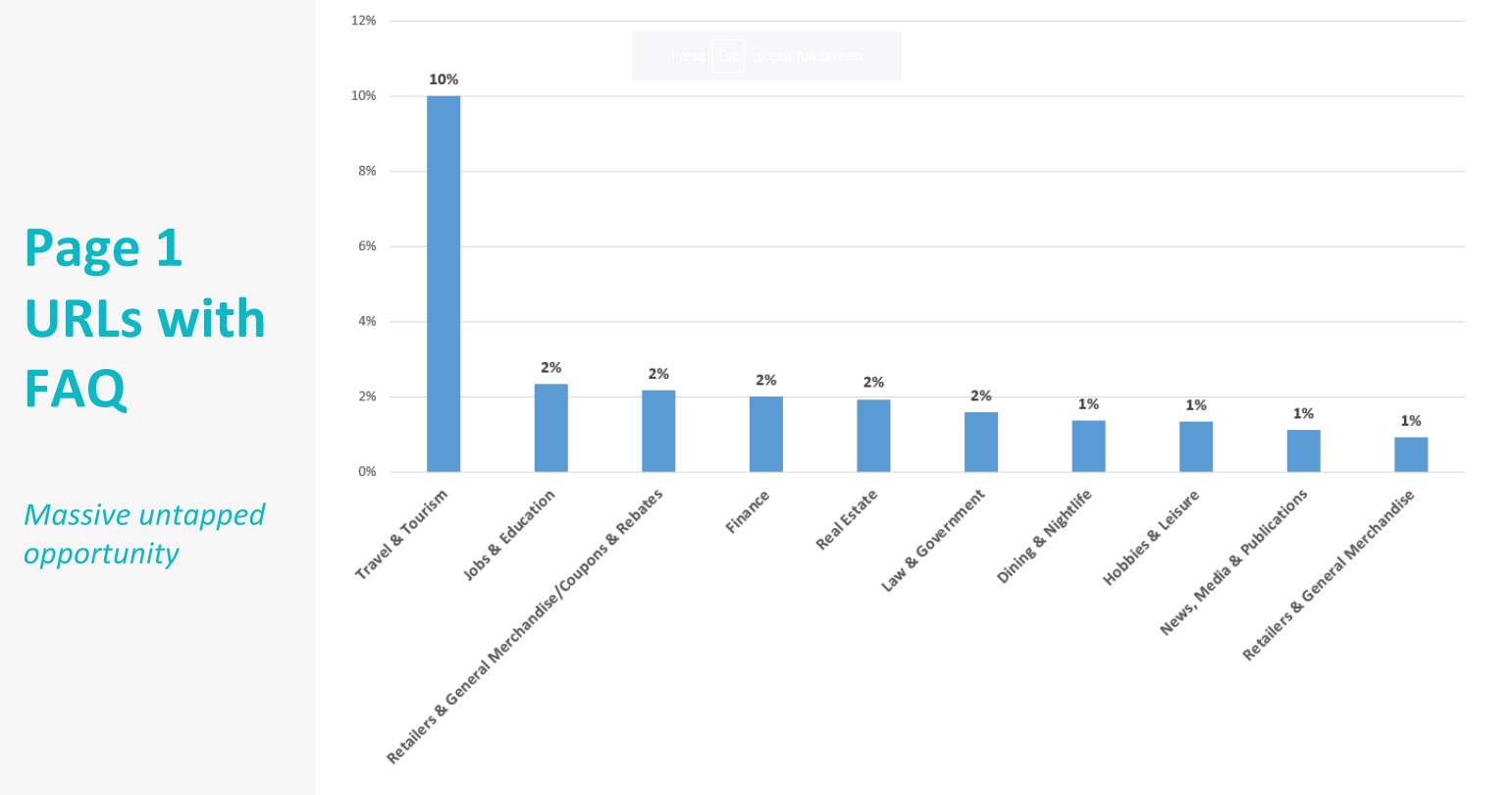
(Frequency of the FAQ markup in different industries.)
Why is this important? Well, for one, because we all have questions when viewing commercial pages. We wonder why the price is so low (or high, for that matter). We ask ourselves how soon could we receive the product or whether we could get free shipping and more.
How does this affect your strategy?
Having a strong FAQ strategy and content on such a page helps eliminate many of the objections customers have for purchasing. And as it turns out, it can help make your SERP listing stand out.
On the other hand, I have to say that the feature adds clutter to an already busy SERP. Hopefully, this is something that sticks and everyone can benefit from.. Otherwise, it’s just adding more scroll to the desktop.
#4. The Curious Case of the Answer Box
Another thing I noticed and would like to share with you is the case of the answer box.
Because, for a time, it seemed that the answer box would become the most prominent feature in SERPs – we predicted the answer box could reach 60% of all keywords. We had been seeing more and more of it, after all. Two years ago, it seemed like there was no stopping the upward climb of the answer box. It went from 12% to 23%. Then, reports came out about how wrong Google was getting some of the answers, and the growth plummeted. Now for Google in the US, the answer box seems to have stabilized at 16%.
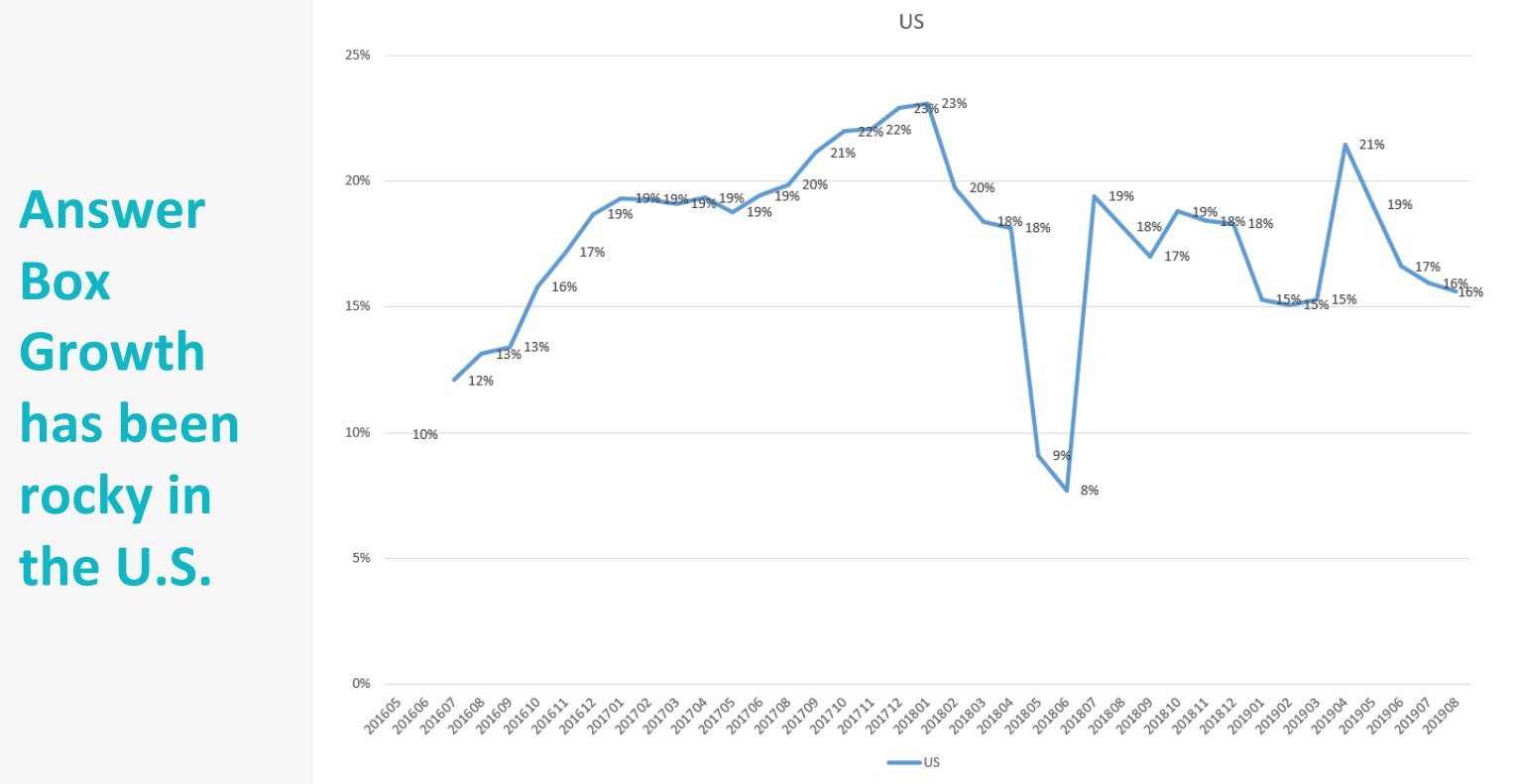
(Answer box fluctuations over the years.)
Answer box growth varies by country. Understandably so, different countries have different access patterns for the web. For example, in India, over 80% of all traffic is from mobile devices running on slow 3G networks, making answer boxes much more useful. It makes sense then that different countries would differently address the answer box opportunity. But it’s not a universal opportunity – answer boxes really vary by industry.
We categorized every keyword we track into multiple industry categories. As you can see, the highest ranking category is Health, with 42.6% of all keywords we track in that category eliciting an answer box. This makes sense – WebMD was the original that everyone learned about answer boxes from.
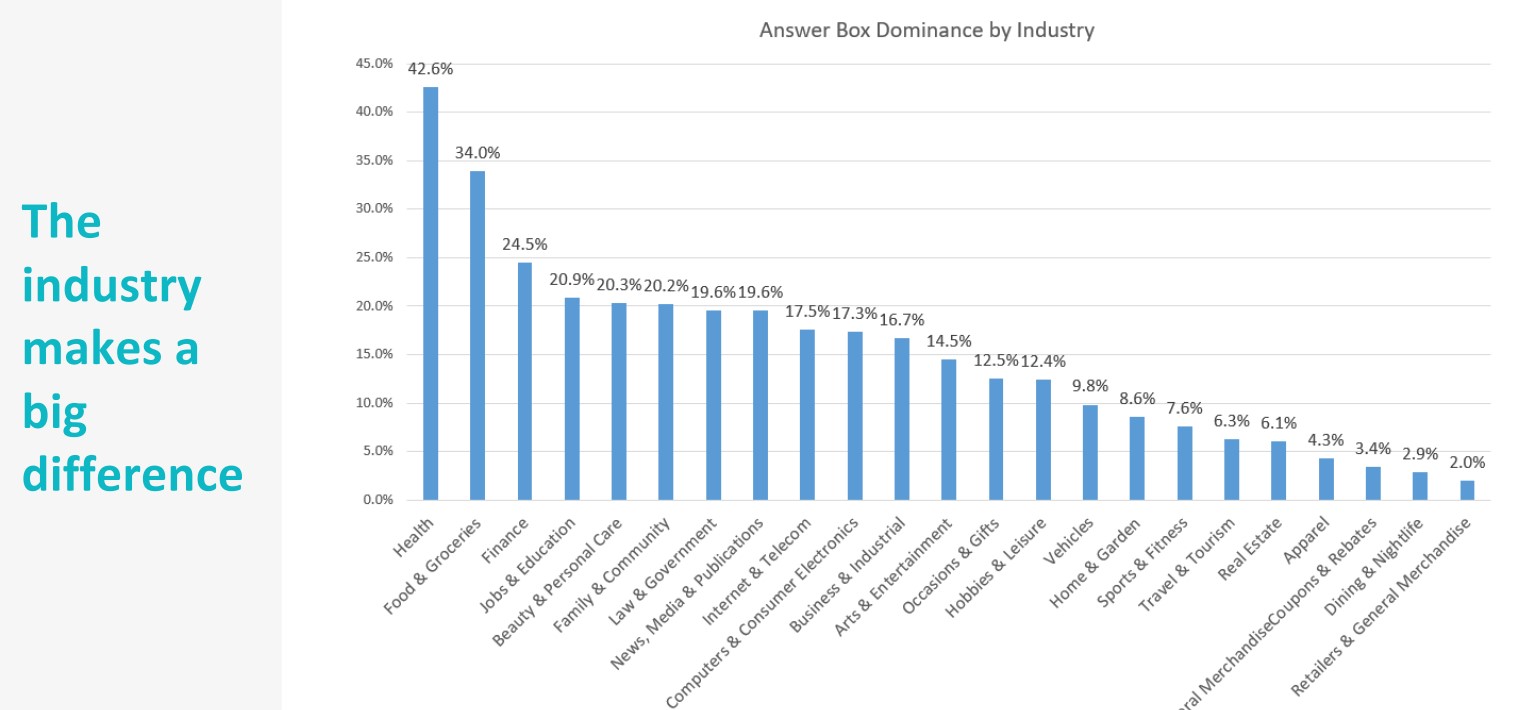
(Answer box prevalence by industry.)
How does this affect your strategy?
For a long time, we believed that it was absolutely paramount to pursue appearing in the answer box. But, depending on your industry, it might not be the most valuable strategy.
#5. Images Gain Space but Do Not Attract Clicks
Finally, we see more and more images in SERPs. Nearly a third of all the keywords we tracked earlier this year had an image result. Of that, nearly 10% of all keywords are in the top five to six positions. This graph highlights how much images have taken up the top ranking positions.
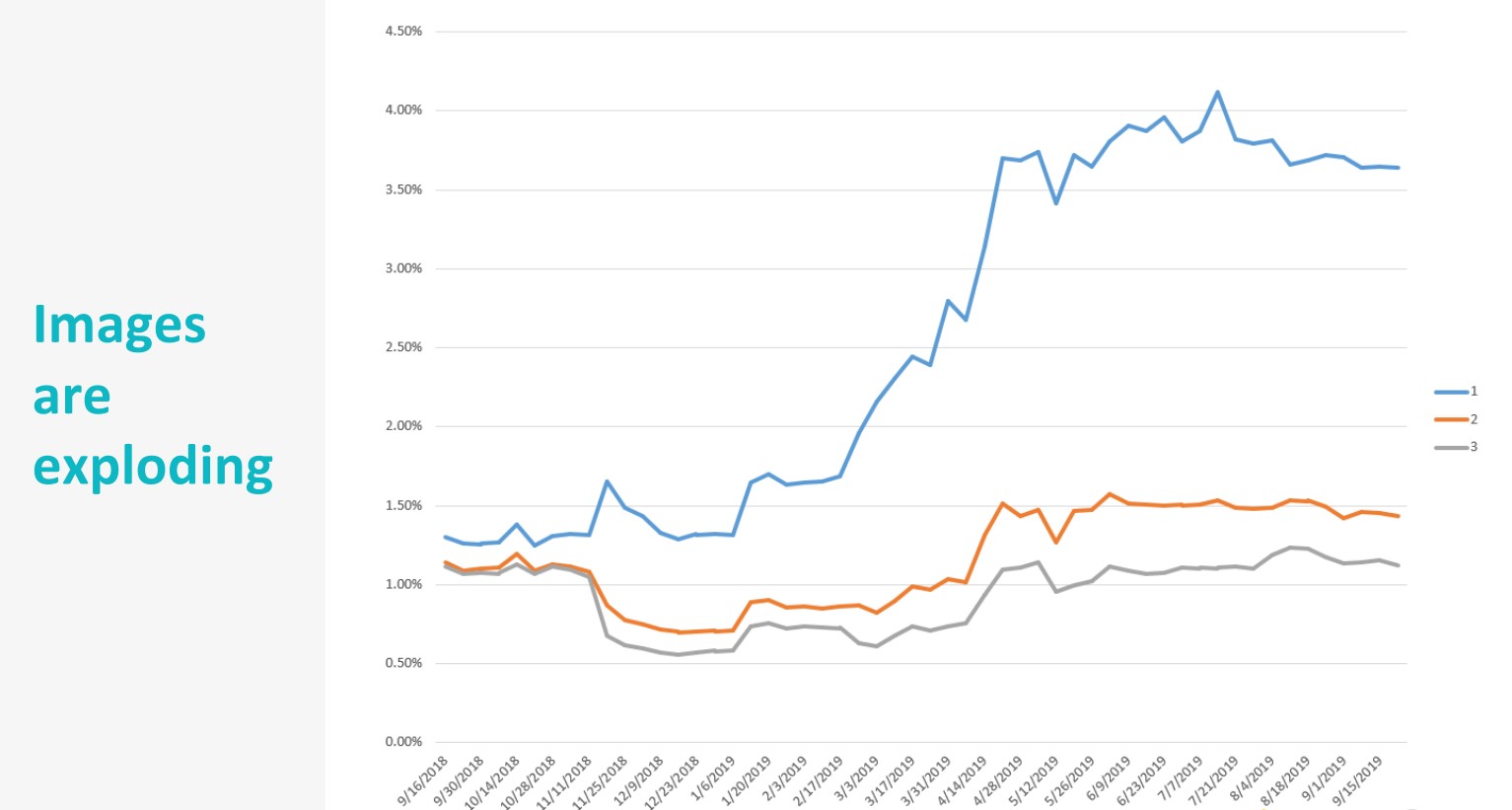
(Images appearing in the top ranking positions.)
People may be doing a lot of searches on Google Images, but do images attract clicks? According to our research, not really. Nobody is actually clicking through in the volumes that would justify an effort around it. Even though images receive impressions, there is nearly nothing in traffic.
Here are the benchmarks we found:
The average CTR from image results is 0.21%, and it varies widely by industry. Keep in mind, this CTR is not a bad amount of traffic when images pull in so many impressions. But at the same time, this means a .21% click-through is your best chance.
Images are an opportunity if you work in a top industries, meaning there’s a higher than average CTR for images. These top industries, listed in descending order of CTR, are People, Real Estate, Health, Fashion, Cars, and Travel.
A super surprising industry with a poor CTR is retail.
Last year, Google tested putting “Buy Now” buttons on images in an attempt to get people to funnel through into an actual transaction. They even announced at Google I/O that they want to start investing in Google Images as a way to be able to show stock information, star ratings, and buy buttons. This means that Google Shopping and Google Images are coming together – they realize the opportunity for monetization.
How does this affect your strategy?
Be mindful of what industry you’re in and what this means for images. Although it may seem that a brand should focus on ranking images, the effort might not pay off as much as you’d like. Particularly if you operate in industries with poor image result CTR, investing time and effort into image SEO might not deliver any significant ROI.
Conclusion
Despite all of these changes, there is still plenty of opportunity in the industry. It’s simply one door closing, and another opening. Having an understanding of these changes will allow you to update your SEO strategy accordingly so you can yield the highest ROI for your efforts and stay ahead in 2020.




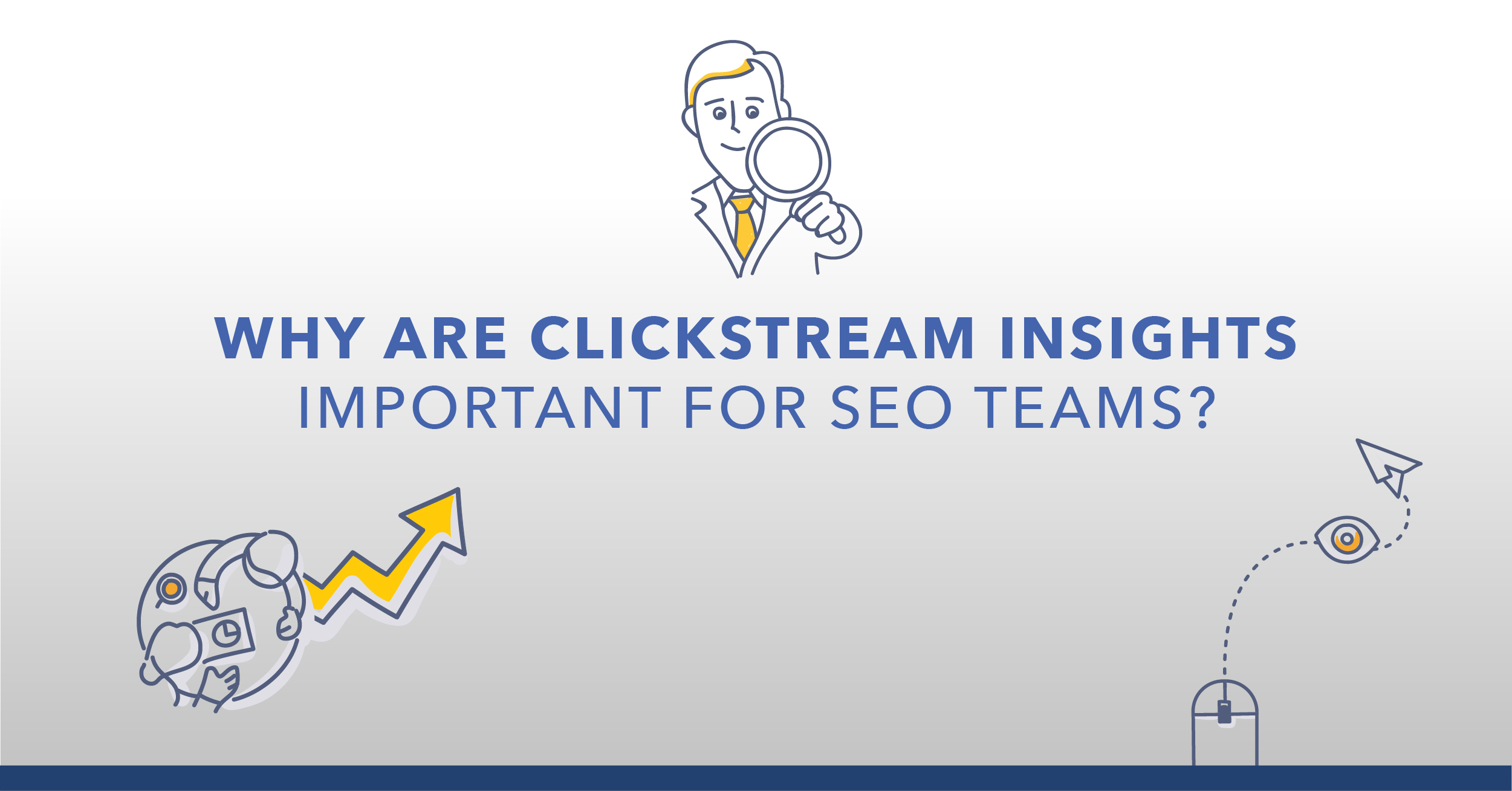
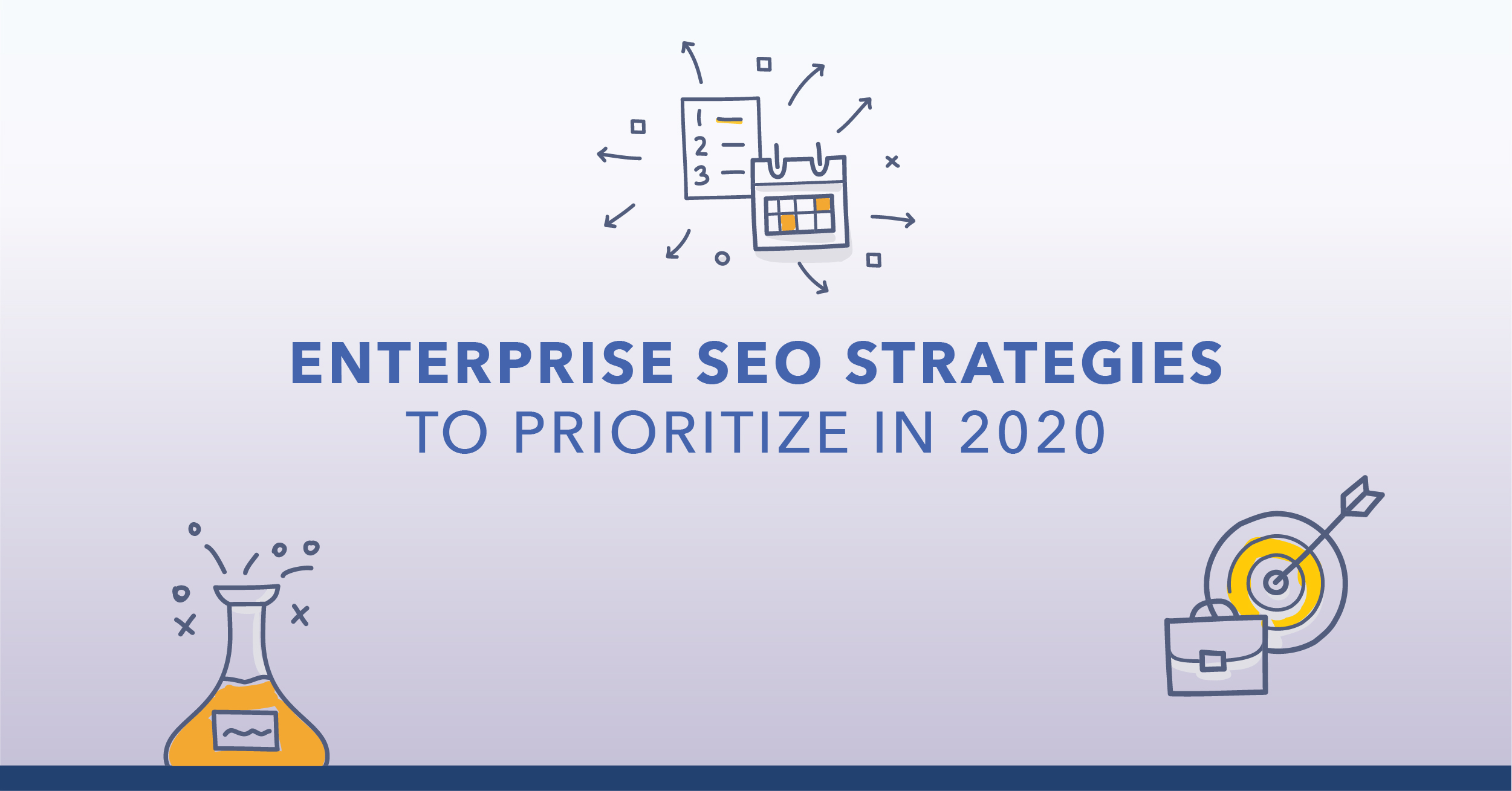
1 Comment
Click here to read/write comments